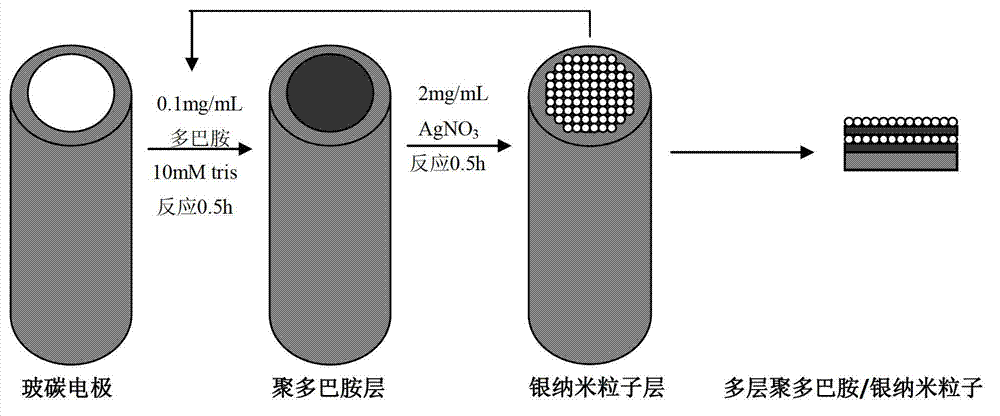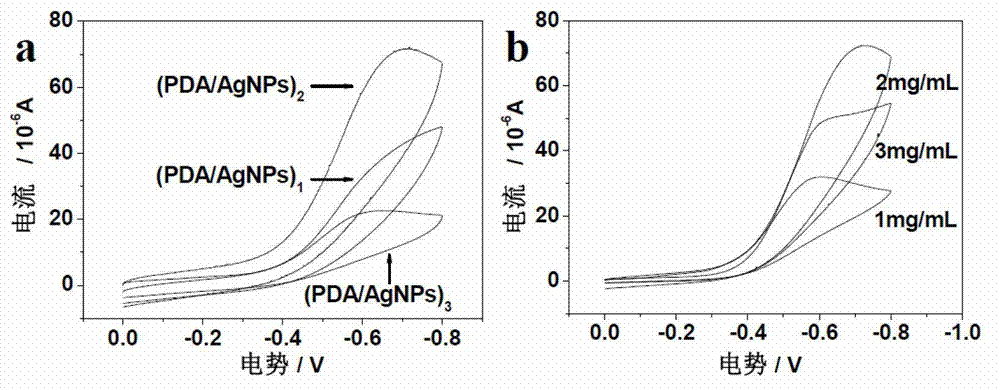Dopamine polymer/noble metal nanoparticle electrochemical sensor as well as preparation method and application thereof
A technology of dopamine and nanoparticles, applied in the direction of material electrochemical variables, etc., can solve the problems of high price and low detection limit
- Summary
- Abstract
- Description
- Claims
- Application Information
AI Technical Summary
Problems solved by technology
Method used
Image
Examples
Embodiment 1
[0031] 1. Preparation and Characterization of Polydopamine / Silver Nanoparticles
[0032] The polydopamine / silver nanoparticle composite was prepared by layer-by-layer assembly method, and the preparation process is shown in the schematic diagram figure 1 . Dopamine solution can be prepared by dissolving dopamine in tris-HCl buffer solution with pH=8.5. 0.1mg / mL dopamine solution was dropped on ITO glass and carbon-coated copper grid respectively, and after drying, 2mg / mL silver nitrate solution was added dropwise, and so on, and multilayer silver nanoparticles could be obtained.
[0033] Using a field emission scanning electron microscope (FESEM, figure 2 ) to characterize the complex. Under aerobic and alkaline conditions, dopamine can easily form a polymer layer on the surface of ITO glass, and its surface is relatively smooth, such as figure 2 as shown in a. After the cleaned polydopamine surface is in contact with silver ions, the silver ions are reduced to silver n...
Embodiment 2
[0042] 1. Preparation of polydopamine / platinum nanoparticles electrochemical sensor
[0043] A glassy carbon electrode with a diameter of 3 mm was polished with sandpaper, Al 2 o 3 (particle size of 0.3 μm) after grinding and polishing, ultrasonically wash with double distilled water, ethanol and double distilled water in sequence. Dissolve 2 mg of dopamine in 20 mL of tris-HCl buffer solution to prepare a 0.1 mg / mL dopamine solution. Add 6 μL of newly prepared dopamine solution dropwise to the treated glassy carbon electrode, and let it dry naturally; then drop 6 μL of 2 mg / mL chloroplatinic acid solution onto the dry polydopamine-modified glassy carbon electrode, and drop repeatedly Plus, a multilayer platinum nanoparticle electrochemical sensor can be fabricated.
[0044] 2. Determination of Hydrogen Peroxide Using Platinum Nanoparticle Electrochemical Sensor
[0045] In 0.1mol / L PBS buffer solution with pH=7.0 or in the test solution containing hydrogen peroxide, use C...
Embodiment 3
[0047] 1. Preparation of poly-levodopa / silver nanoparticles electrochemical sensor
[0048] A glassy carbon electrode with a diameter of 3 mm was polished with sandpaper, Al 2 o 3 (particle size of 0.3 μm) after grinding and polishing, ultrasonically wash with double distilled water, ethanol and double distilled water in sequence. Dissolve 2 mg of levodopa in 20 mL of tris-HCl buffer solution to prepare a 0.1 mg / mL levodopa solution. Add 6 μL of newly prepared levodopa solution dropwise to the treated glassy carbon electrode and let it dry naturally; then drop 6 μL of 2 mg / mL silver nitrate solution onto the dry poly-levodopa-modified glassy carbon electrode , repeated dropwise, can make multi-layer silver nanoparticles electrochemical sensor.
[0049] 2. Determination of hydrogen peroxide using silver nanoparticles electrochemical sensor
[0050] In 0.1mol / L PBS buffer solution with pH=7.0 or in the test solution containing hydrogen peroxide, use CHI660c electrochemical a...
PUM
| Property | Measurement | Unit |
|---|---|---|
| Concentration | aaaaa | aaaaa |
Abstract
Description
Claims
Application Information
 Login to View More
Login to View More - R&D
- Intellectual Property
- Life Sciences
- Materials
- Tech Scout
- Unparalleled Data Quality
- Higher Quality Content
- 60% Fewer Hallucinations
Browse by: Latest US Patents, China's latest patents, Technical Efficacy Thesaurus, Application Domain, Technology Topic, Popular Technical Reports.
© 2025 PatSnap. All rights reserved.Legal|Privacy policy|Modern Slavery Act Transparency Statement|Sitemap|About US| Contact US: help@patsnap.com



